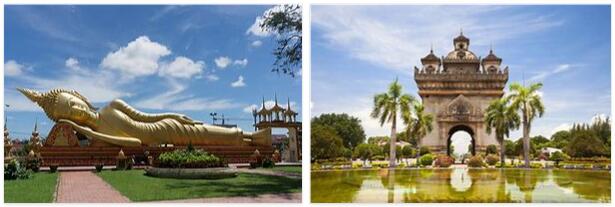Vientiane is the smallest capital in Southeast Asia (only about 500 thousand people live on an area of about 180 sq. km). Translated from Lao, the name of the city sounds like “Sandalwood (Fragrant) City” This town has experienced many events in its history: In 1563, King Settatirat turned a small village into the capital of the Lan Xang kingdom, in 1827 Vientiane was captured by the Siamese army and almost completely destroyed. For many decades, the city lay in ruins until the French colonizers rebuilt it. Modern Vientiane is a harmonious combination of French colonial style and ancient Lao architectural traditions with numerous temples and monasteries.
Stupa That Luang:
The gilded stupa That Luang is the main national symbol of Laos. According to legend, many centuries ago it was founded by Indian pilgrims who presented the Lao king with a sacred relic – Buddha’s hair. The relic was walled up in a seven-meter stupa specially built for it, called That. Gradually, an ensemble of Buddhist buildings formed around the main stupa, and That Luang acquired its modern look in 1566 and for several centuries became the intellectual center of Buddhism in Indochina, where monks from Siam and Cambodia studied. Ensemble That Luang strikes with the perfection and grace of forms. Like most Buddhist religious buildings, That Luang is a stepped structure. The base of the stupa is a wide terrace surrounded by a two-meter wall with small cells for prayers and offerings. The stupa is surrounded by a quadrangular fence. In the middle of each of the four walls of the fence there are pavilion gates through which visitors enter the complex. The high spire of the stupa symbolizes Mount Meru, the center of the world in Buddhism and Hinduism. Every year on the thirteenth day of the twelfth lunar month, just like hundreds of years ago, faithful to their traditions, thousands of Laotians flock to the square in front of the stupa for festivities and festivities.
Wat Sisaket:
Built in 1818, this Buddhist temple is said to be the oldest intact temple in Vientiane. A special detail of the temple are 7,000 Buddha statues made of silver, wood and bronze, located in niches around the perimeter of the wall. Inside the temple is a statue of the Sitting Buddha of the 17th century. The ceiling of the temple is painted with beautiful frescoes from the life of Buddha.
Wat Phra Kaew:
This temple was built in 1565 and is known for housing the
famous Emerald Buddha statue until 1778, which is today one of the main
symbols of Bangkok. The temple itself was destroyed in 1828-1829 during the next capture of Vientiane by the Thai army, and subsequently restored. Currently, there is a museum where the belongings of the royal family and several valuable Buddha statues are exhibited.
Wat Si Muang:
Wat Si Muang is the city’s most revered temple, where residents pray to the spirits of the city, who, according to local belief, live in a phallic column found on the site of one of the ancient Khmer cities in the 16th century. According to legend, when the place for the temple was chosen, and the foundation pit was dug for its foundation, everyone was waiting for a volunteer who was ready to sacrifice himself to the Gods. In the end, obeying the call of the Gods, a pregnant woman rushed into the pit.
Black Stupa:
This is the oldest weaponry in Vientiane, dating back to the 15th century. Previously, it was covered with gold plates, but in 1828 they were removed and taken by the Thais to Thailand, and now they are abundantly overgrown with moss. According to legend, a seven-headed dragon lives in this stupa – the main patron and protector of the city.
Triumphal arch of Patusai The
triumphal arch of an unusual appearance in the style of a Parisian triumphal arch, but with elements of local color, was installed in 1968 in memory of those who died in the war for the independence of Laos. The main feature of the arch is an observation deck overlooking the center of Vientiane. This is the tallest building in Vientiane, building taller is prohibited by the government.
National Historical Museum:
This museum is located in the former residence of the French governor and contains archaeological finds, photographs, examples of Lao folk art and handicrafts.
Buddha Park:
The park is located 24 km. south of Vientiane, and although it does not represent any particular historical or artistic value, it still attracts a large number of visitors with its unusualness. The park was created in 1958 by a Thai sculptor inspired by the symbols of ancient Buddhism and Judaism. The park contains statues of Buddha, mythical heroes and creatures, animals, fish, birds, made of reinforced concrete.
